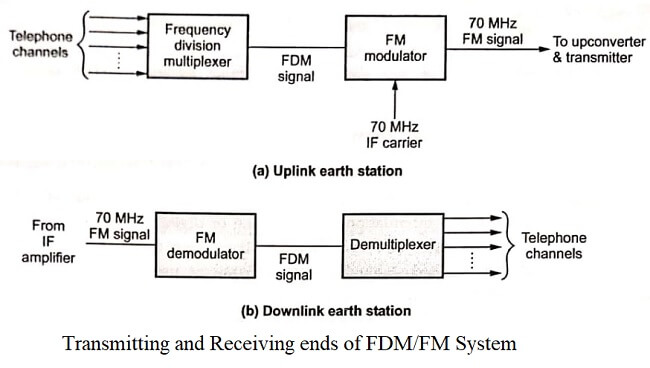The communications satellites are used to carry telephone, television and data signals. The television and telephone signals are normally analog. The satellite earth station transmits these signals on the same link by multiplexing. Time division multiplexing (TDM) and frequency division (FDM) are the commonly used multiplexing techniques.
FDM/FM for Telephone Systems

Fig shows the block diagram of FDM/FM system used for telephone systems. The multiplexer generates FDM signal from many telephone channels. Each telephone channel is assigned a fixed frequency band in FDM signal. This FDM signal is frequency modulated on 700 MHz IF carrier. This signal is then upconverted to uplink frequency and transmitted to satellite. Similarly as shown in Fig (b), the signal from the satellite is downconverted 70 MHz IF. It is then demodulated by the FM demodulator. The output of the FM demodulator is the FDM signal, which is demultiplexed to generate different telephone channels.
FM-SCPC Systems
The single channel per carrier (SCPC) systems transmit each telephone channel on its own carrier. Hence there is no multiplexing like FDM/FM. When there are very few channels, then SCPC system can be used. It reduces the cost of the earth station. The SCPC systems are reconfigurable as per traffic conditions. Hence they are compatible with the demand assignment systems. These systems are discussed next. The carrier for the SCPC channel is transmitted only when the link is active. This reduces the transponder power consumption. Table shows the comparison of FDM/FM and SCPC systems.
Comparison of FDM/FM and SCPC
| FDM/FM | SCPC |
| Carrier is always present for every channel. | Carrier is transmitted only when the link is active i.e. when channel is being used. |
| Transponder power consumption is more. | Transponder power consumption is less. |
| Multiplexing is used. Hence less bandwidth requirement. | No multiplexing. Hence more bandwidth requirement. |
| Used for heavy load on all the channels. | Used for light load on the channels. |
| Read More Topics |
| Multiple access techniques |
| Orbital aspects of satellite communication |
| Satellite communication system |





